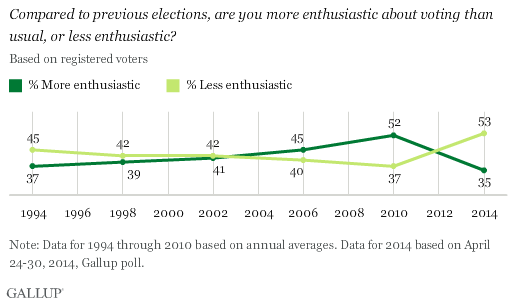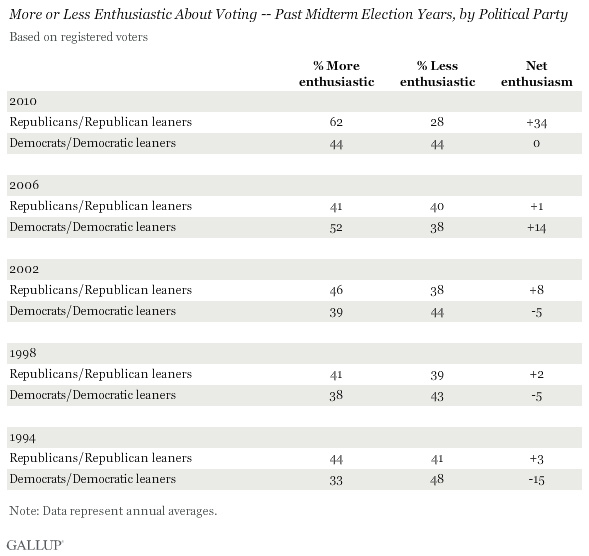PRINCETON, NJ -- A majority of U.S. registered voters, 53%, say they are less enthusiastic about voting than in previous elections, while 35% are more enthusiastic. This 18-percentage-point enthusiasm deficit is larger than what Gallup has measured in prior midterm election years, particularly in 2010 when there was record midterm enthusiasm.

Among registered voters, 42% of Republicans and Republican-leaning independents currently say they are more enthusiastic than usual about voting, while 50% are less enthusiastic, resulting in an eight-point enthusiasm deficit. But Democrats are even less enthusiastic, with a 23-point deficit (32% more enthusiastic vs. 55% less enthusiastic).
Typically, the party whose supporters have an advantage in enthusiasm has done better in midterm elections. Republicans had decided advantages in enthusiasm in 1994, 2002, and especially 2010 -- years in which they won control of the House of Representatives or expanded on their existing majority. Democrats had the advantage in 2006, the year they won control of the House. Neither party had a decided advantage in 1998, a year Democrats posted minimal gains in House seats.

Although there is an apparent link between voter enthusiasm and midterm election outcomes, the mechanism through which that occurs is unclear. To some degree, greater enthusiasm may mean greater motivation to vote among the more enthusiastic party. However, Gallup has not been able to demonstrate that is the case, partly because changes in party affiliation from one midterm year to the next correlate with changes in enthusiasm by party.
Irrespective of whether a voter plans to turn out, enthusiasm may also be an expression of voters' optimism or pessimism about whether their party will have a strong or weak showing in the election.
Americans Not Highly Engaged in Election
A separate measure, one that historically has been predictive of turnout, asks Americans how much thought they have given to the election. Currently, 26% of Americans say they have given "quite a lot" or "some" thought to this year's midterm elections, much lower than Gallup's initial measurement in 2010 (37%) but on par with early readings in 2006 (28%) and 1998 (29%).
Not surprisingly, Americans usually give more thought to the election as it draws nearer -- but in midterm election years, that typically has represented only about half of the public right before the election. The lower level of engagement at this point compared with similar points in prior years may indicate that overall voter turnout will be lower than in the last two midterm election years.
Currently, 37% of Republicans say they have given at least some thought to the election, compared with 24% of Democrats. Republicans' scores on this measure almost always exceed those for Democrats, so the size of the advantage is what matters for predicted turnout. The current 13-point Republican advantage in election thought is slightly smaller than the 2010 average of 15, but larger than the 2006 and 2002 averages of two and four points, respectively. That suggests Republicans may enjoy an above-average advantage in turnout this year, although perhaps not as significant as in 2010.
Implications
The thought and enthusiasm measures together suggest a mixed picture for Republicans. On one hand, it seems clear that 2014 will not be a repeat of 2010, when record Republican enthusiasm presaged major gains for the party in Congress. This year, Republicans' reported enthusiasm not only pales in comparison to 2010, but also to every other midterm election year.
However, Republicans still maintain advantages in thought given to the election and in voter enthusiasm compared with Democrats, and these advantages normally point to a better year for Republicans than Democrats. There is some uncertainty about how that will play out this year given that both Republicans and Democrats say they are less enthusiastic than usual about voting -- something that has occasionally occurred in past midterm election years but never over the course of an entire midterm campaign.
Survey Methods
Results for this Gallup poll are based on telephone interviews conducted April 24-30, 2014, with a random sample of 1,513 adults, aged 18 and older, living in all 50 U.S. states and the District of Columbia.
For results based on the total sample of national adults, the margin of sampling error is ±3 percentage points at the 95% confidence level.
For results based on the total sample of 1,336 registered voters, the margin of sampling error is ±3 percentage points at the 95% confidence level.
Interviews are conducted with respondents on landline telephones and cellular phones, with interviews conducted in Spanish for respondents who are primarily Spanish-speaking. Each sample of national adults includes a minimum quota of 50% cellphone respondents and 50% landline respondents, with additional minimum quotas by time zone within region. Landline and cellular telephone numbers are selected using random-digit-dial methods. Landline respondents are chosen at random within each household on the basis of which member had the most recent birthday.
Samples are weighted to correct for unequal selection probability, nonresponse, and double coverage of landline and cell users in the two sampling frames. They are also weighted to match the national demographics of gender, age, race, Hispanic ethnicity, education, region, population density, and phone status (cellphone only/landline only/both, and cellphone mostly). Demographic weighting targets are based on the most recent Current Population Survey figures for the aged 18 and older U.S. population. Phone status targets are based on the most recent National Health Interview Survey. Population density targets are based on the most recent U.S. census. All reported margins of sampling error include the computed design effects for weighting.
In addition to sampling error, question wording and practical difficulties in conducting surveys can introduce error or bias into the findings of public opinion polls.
View survey methodology, complete question responses, and trends.
For more details on Gallup's polling methodology, visit www.gallup.com.
